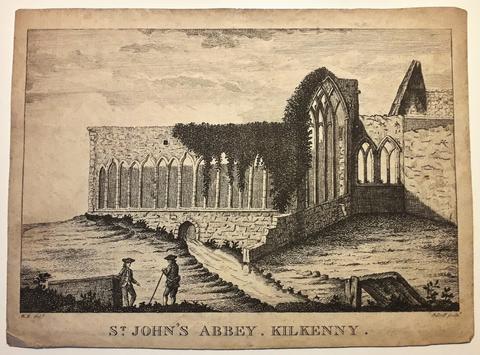referentie code
Titel
Datum(s)
- c.1781-1790 (Vervaardig)
Beschrijvingsniveau
Omvang en medium
17 cm x 12.5 cm; Engraving
Naam van de archiefvormer
archiefbewaarplaats
Geschiedenis van het archief
Directe bron van verwerving of overbrenging
Bereik en inhoud
An engraving of St. John’s Abbey, Kilkenny. The print is probably taken from Edward Ledwich’s 'The History of Antiquities of Irishtown and Kilkenny', which contains plates of ‘St. John’s Abbey, Kilkenny’ and the ‘East Window of Dunamase Abbey’, engraved from W. Beauford’s drawings by J. Duff.
Waardering, vernietiging en slectie
Aanvullingen
Ordeningstelsel
Voorwaarden voor raadpleging
Voorwaarden voor reproductie
Taal van het materiaal
Schrift van het materiaal
Taal en schrift aantekeningen
Fysieke eigenschappen en technische eisen
Toegangen
Bestaan en verblifplaats van originelen
Bestaan en verblijfplaats van kopieën
Related units of description
Aantekening
Edward Ledwich (c.1737-1823), a Dublin-born historian, antiquarian, and topographer. The engraving dates to about 1781. St. John’s Abbey (also known as St John’s Priory) is a medieval Augustinian abbey. In 1211 William Marshal, Earl of Pembroke, an Anglo-Norman soldier, granted land on the east bank of the River Nore to the Augustinians. This new church was afterwards known as the Priory of St. John the Evangelist. The abbey and priory church remained centres of worship until 1540 when they were suppressed by Henry VIII. In about 1667 the Capuchin friars secured a portion of St. John’s Abbey and a plot of ground on nearby St. Michael’s Lane where they established a hospice and an oratory. By 1678 the Capuchins had a community of three friars in Kilkenny. The Capuchin house adjoining St. John’s Abbey was ultimately closed in 1698 after the passage of a parliamentary Act of Banishment which aimed to expel all Catholic religious orders from Ireland. St. John’s Abbey church did not resume its religious aspect until 1817 when the still-standing portion of the building (known as the ‘Lady Chapel’) was repaired and consecrated as a Church of Ireland (Anglican) parish church which is still in use.

